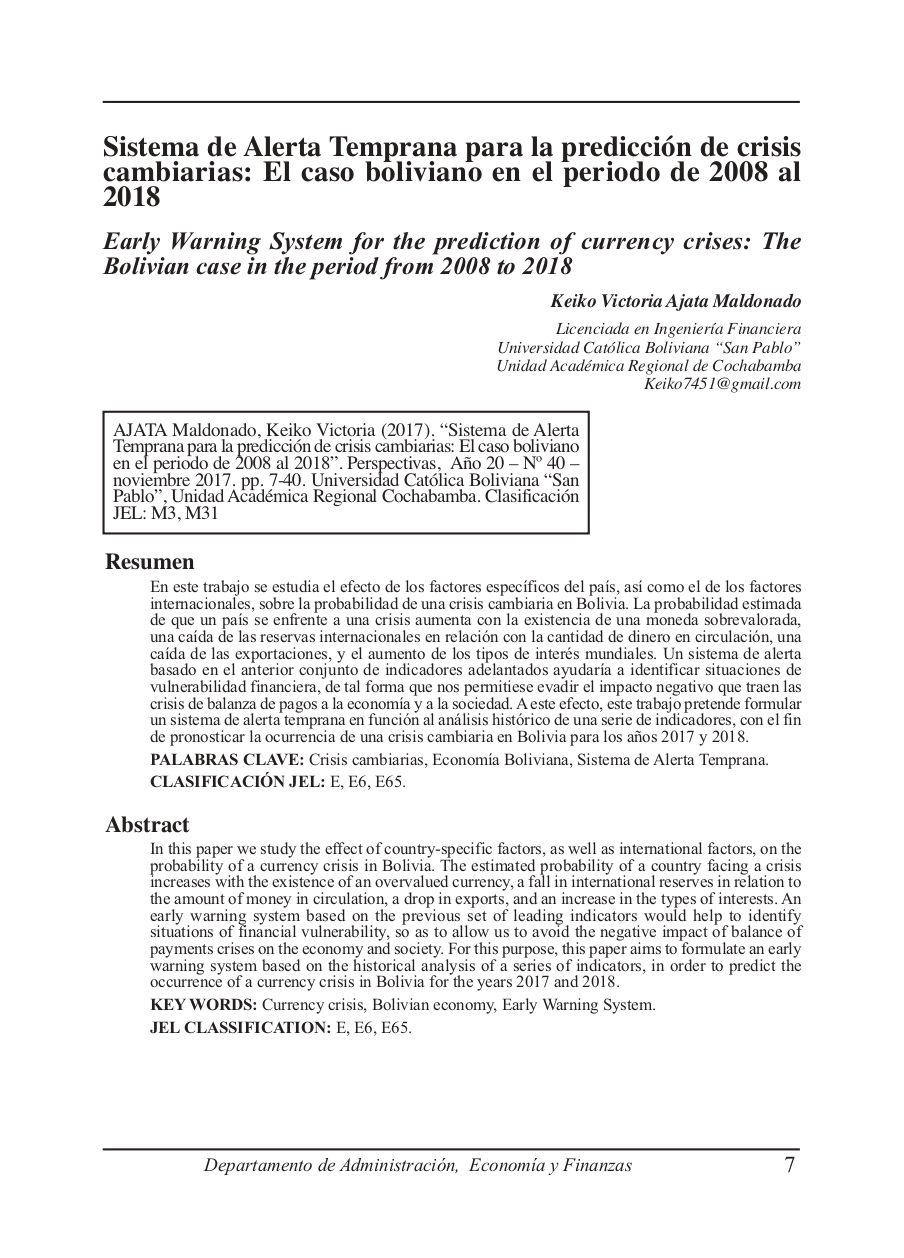Early Warning System for the prediction of currency crises: The Bolivian case in the period from 2008 to 2018
DOI:
https://doi.org/10.35319/0w6v4n44Keywords:
Currency crisis, Bolivian economy, Early Warning SystemAbstract
In this paper we study the effect of country-specific factors, as well as international factors, on the probability of a currency crisis in Bolivia. The estimated probability of a country facing a crisis increases with the existence of an overvalued currency, a fall in international reserves in relation to the amount of money in circulation, a drop in exports, and an increase in the types of interests. An early warning system based on the previous set of leading indicators would help to identify situations of financial vulnerability, so as to allow us to avoid the negative impact of balance of payments crises on the economy and society. For this purpose, this paper aims to formulate an early warning system based on the historical analysis of a series of indicators, in order to predict the occurrence of a currency crisis in Bolivia for the years 2017 and 2018.
Downloads
References
Álvarez, V., & Rossignolo, A. (2010). Teoría de valores extremos (EVT) y grandes crisis financieras: Mercados emergentes vs. desarrollados. Departamento Académico de Administración de Empresas.
Bernardino, B. (2010). Crisis cambiarias en países emergentes: Modelos empíricos de explicación y predicción. España: Ediciones Uninorte.
Calvo, S., & Reinhart, C. (1996). Capital inflows to Latin América: Is there evidence of contagion effects. En G. Calvo, M. Goldstein & E. Hochreiter (Eds.), Private capital flows to emerging markets (pp. [sin número]). Washington, DC: Institute for International Economics.
Eichengreen, B., Rose, A. K., & Wyplosz, C. (1995). Exchange rate mayhem: The antecedents and the aftermaths of speculative attacks. Economic Policy, 21, 251–312.
Eichengreen, B., Rose, A. K., & Wyplosz, C. (1996). Contagious currency crises. Scandinavian Journal of Economics, 98(4), 463–484.
Eichengreen, B., & Rose, A. (s.f.). The empirics of currency and banking crises. Economics Department, University of California.
Fokianos, B. K. (2002). Regression models for time series analysis. Wiley Interscience.
Frankel, J., & Rose, A. K. (1996). Currency crashes in emerging markets: An empirical treatment. Journal of International Economics, 41(3–4), 351–366.
Gencay, R., Selçuk, F., & Ulugülyagci, A. (2002). EVIM: A software package for extreme value analysis in MATLAB. Working Paper, University of Windsor, Ontario.
Giraldo, J. A. (2008). Indicadores de alerta temprana de vulnerabilidad macroeconómica. Revista EIA, Escuela de Ingeniería de Antioquia.
Goldstein, M., Kaminsky, G., & Reinhart, C. (2000). Assessing financial vulnerability: An early warning system for emerging markets. Institute of International Economics.
Gujarati, D. (2006). Principios de econometría (3ª ed.). Editorial McGraw Hill.
Guerrero, G. (2008). Evaluación del desempeño de modelos VaR usando la teoría de valores extremos en mercados emergentes y desarrollados. Universidad Complutense de Madrid. Trabajo de investigación 08/007.
Kaminsky, G. (2000). Currency and banking crises: The early warning of distress. Working Paper, George Washington University.
Kaminsky, G. (2006). Currency crises: Are they all the same? Journal of International Money and Finance, 25, 503–527.
Kaminsky, G., Lizondo, S., & Reinhart, C. (1998). Leading indicators of currency crises. IMF Staff Papers, 45(1), Fondo Monetario Internacional, Washington D.C.
Kaminsky, G., & Reinhart, C. (1998). Financial crises in Asia and Latin America: Then and now. American Economic Review, 88(2), 444–448.
Kaminsky, G., & Reinhart, C. (1999). The twin crises: The causes of banking and balance-of-payments problems. American Economic Review, 89(3), 473–500.
Krugman, P. (1979). A model of balance-of-payments crises. Journal of Money, Credit and Banking, 11, 311–325.
Lestano, & Jacobs, J. (2003). Indicators of financial crises do work! An early-warning system for six Asian countries. Working Paper, Department of Economics, University of Groningen.
Lestano, & Jacobs, J. (2004). A comparison of currency crises dating methods: East Asia 1970–2002. CCSO Working Paper No. 2004/12, Department of Economics, University of Groningen.
Lilliefors, H. W. (1967). On the Kolmogorov-Smirnov test for normality with mean and variance unknown. Journal of the American Statistical Association, 62, 399–402.
Pindyck, R., & Rubinfeld, D. (2001). Econometría: Modelos y pronósticos (4ª ed.). México: McGraw Hill.
Queijero, S., Álvarez, P., Pérez, J., & Pardo, C. (2007). ¿Qué identifican los indicadores de crisis cambiarias? Una nota metodológica sobre la identificación empírica de crisis cambiarias. Tribuna de Economía, ICE, Madrid, 297–309.
Rahman, A. F. M. A., & Hasan, R. (2014). Currency crisis in Bangladesh economy: Some insights. Journal of Finance and Economics, 2(1), 7–16.
Sachs, J., Tornell, A., & Velasco, A. (1996). Financial crises in emerging markets: The lessons from 1995. Brookings Papers on Economic Activity, 1, 147–215.

Downloads
Published
Issue
Section
License
Copyright (c) 2017 Revista Perspectivas

This work is licensed under a Creative Commons Attribution-NonCommercial-ShareAlike 4.0 International License.
La Revista Perspectivas de la Universidad Católica Boliviana, es una revista de acceso abierto, por lo tanto, es de libre acceso en su integridad. Está permitida su lectura, búsqueda, descarga, distribución y reutilización legal en cualquier tipo de soporte únicamente para fines no comerciales, siempre y cuando la obra sea debidamente citada.




